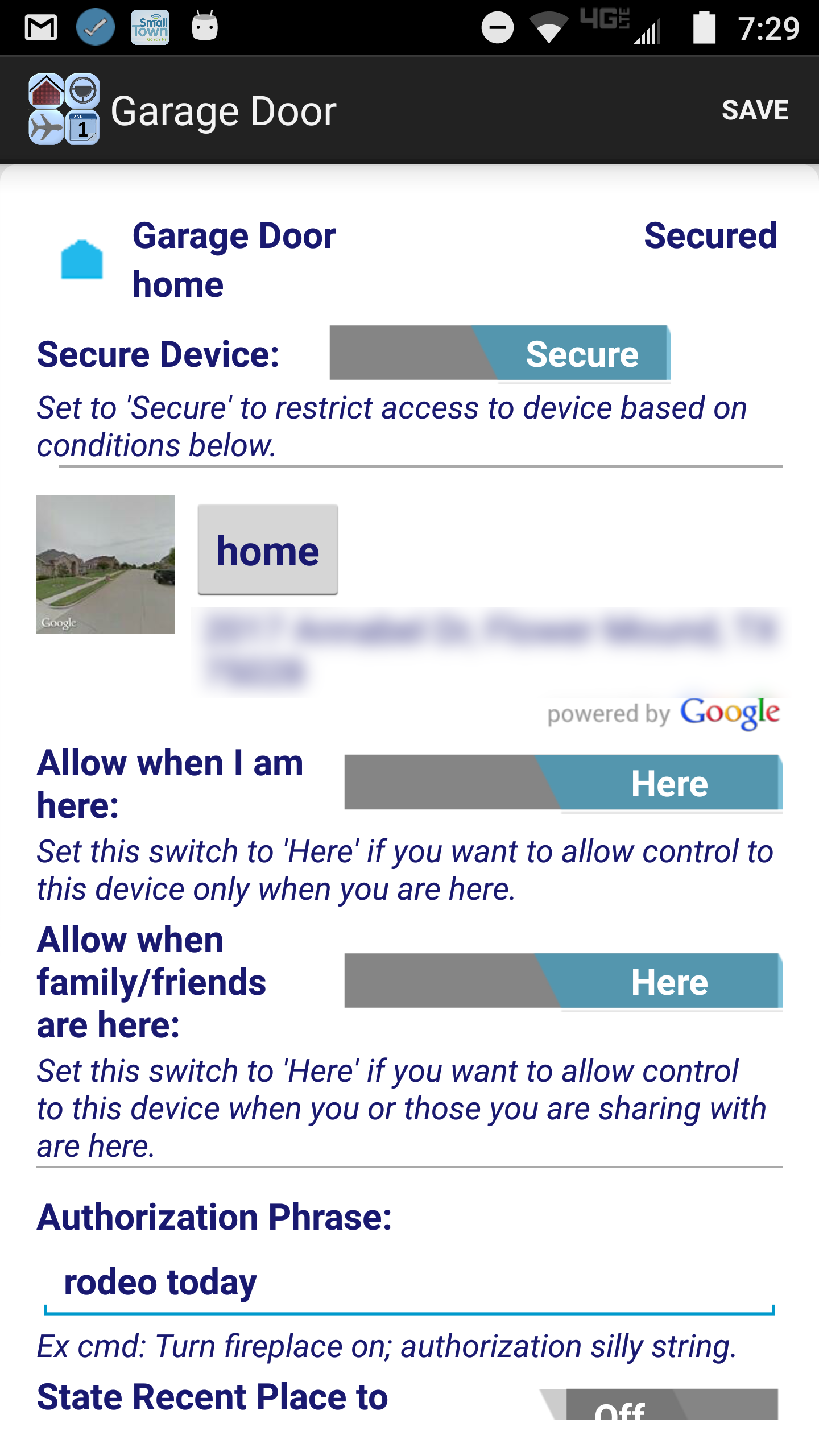Now you can use Alexa and issue contextually intelligent commands. Context is created and provided by the iDid app.
Download and install version 15 or greater of the iDid application from the Google Play Store: iDid: Your Digital Avatar. Note at this point the iDid-Alexa interface is only supported on the Android version of the app.
For a quick overview of the iDid app, see https://idid-inc.com/idid. See how we can help you use Alexa in your business and contact us.
Installing the “iDid: Your Digital Avatar” application:
- Install the iDid Android application. You will be taken through the welcome screens where you will select a Calendar for iDid to log events to.
- When you get to the Sharing Context screen you will be asked to log-in through Google. You will use the same login later using the Alexa app on your Android phone, so that both accounts are linked. Note that this is the email address others will use to share their location and context with you. This email is your iDid identity. Make sure this email address is in your phone contacts with your name, mobile number and preferably a picture.
- After iDid starts, it will show you your current location in the Activities view. Initially, you’ll see where it says, “No place name yet…”. Give it a minute or two to finalize your place and activity.
- iDid will automatically customize place names for “home” and “work” as it learns in a day or two. However, to start testing the Alexa-iDid voice interface and try the examples below, create a custom place called ‘home’. In the ‘Activities’ view, hit the ‘Actions’ button for your current activity (top-most for today) and customize the place on the following screen with an alias. Hit ‘Done’ to save.
Installing the Alexa skill:
- On your Alexa Android app, search for the “iDid: Your Digital Avatar” skill and install it.
- Link your Alexa iDid skill with your iDid app by logging in with the same Google account you used when you installed your iDid app. Do this by enabling Account Linking for the skill.
- Once linked, you can give commands to your iDid app through Alexa. The invocation name is “my avatar”.
Commands issued through Alexa:
Let’s say Bernie (me) is talking to the iDid app through Alexa.
- Bernie: “Alexa, launch my Avatar”
- Alexa: “Hi Bernie. What can I do for you?”
If you get this response that means that Alexa is able to communicate to your iDid app and the accounts are correctly linked. This very first command may take a few seconds longer than subsequent ones (to go through security protocols).
Locating People
Have a friend or family member download and install the iDid app (on Android). You can share your location with each other: Open the MAP View and select Share Location from the menu. Follow the instructions and select each others’ email to share (this must be the email you used to login into Google when you installed the iDid app). Note that email is just used as your identity. Sharing does not send or receive locations by email. Once you are done sharing, you can see each other in your Map view. Now, you can ask Alexa to locate each other as well:
- Bernie: “Alexa, ask my Avatar to locate Cathy”
- Alexa: “Cathy is at work. 14201 Dallas Pkwy, Dallas, TX 75254”
- You may get a response with a customized place name, a public place name or an address – or a combination. Your iDid app will launch in Map view and plot the person on the map as well. If you have a picture in your contacts, that picture will be used for the plot.
Locate the Phone
You can use the above ‘Locate People’ command to locate yourself if you misplaced your phone by asking my Avatar, “Where am I?”. If you get the response that you are at home (or where you issued the Alexa command), you would normally attempt to find your phone by calling it from another phone. Instead, you can use this ‘Locate Phone’ command. You don’t need another phone:
- Bernie: “Alexa, ask my Avatar to locate my phone”
- Alexa: “Okay.”
Your phone rings. This works (rings) even if your phone was set on vibrate or silent.
Smart Reminders
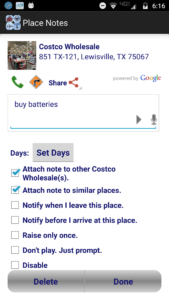 You can set up many smart reminders with iDid and now it’s even easier by simply talking to Alexa. Smart reminders can be attached to places and events. See Contextual Triggers for a summary discussion on the kinds of triggers iDid supports.
You can set up many smart reminders with iDid and now it’s even easier by simply talking to Alexa. Smart reminders can be attached to places and events. See Contextual Triggers for a summary discussion on the kinds of triggers iDid supports.
When attaching to places, you can configure them to activate when you are at that place or before you arrive or after you leave. Here are some examples below. Note that as you issue these commands, corresponding screens pop-up on the iDid app (confirming your actions).
- Bernie: “Alexa, ask my Avatar to remind me to buy batteries at Costco”
- Alexa: “You will be reminded with note: Buy batteries, at Costco Wholesale.”
When you visit Costco, your iDid app will remind you to get batteries. This reminder is automatically attached to other places like Costco and is set to play as an audio note. You can change it to just raise a notification with a chime on the iDid app – or use the term “notify” instead of remind: “Alexa, ask my Avatar to notify me to buy batteries at Costco.”
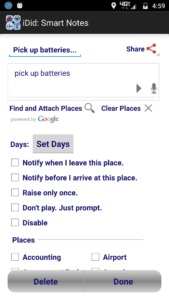 The app can automatically attach suitable places and times to your reminders based on the reminder content itself. Try this:
The app can automatically attach suitable places and times to your reminders based on the reminder content itself. Try this:
- Bernie: “Alexa, ask my Avatar to remind me to pick up batteries”
- Alexa: “You will be reminded with note: Pick up batteries, at suitable places.”
- Bernie: “Alexa, ask my Avatar to remind me to pick up dry cleaning when I leave”
- Alexa: “You will be reminded with note: pick up dry cleaning, after leaving home.”
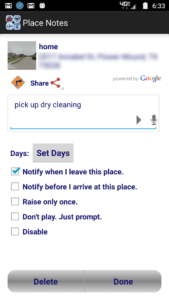 The iDid app will automatically detect and customize place names, “home” and “work”. It may take a couple of days for the app to arrive at this customization automatically. You can manually customize if you’d like to issue commands that use “home” or “work” in the meanwhile. Note that “Notify when I leave this place” is checked. iDid will remind you when it detects that you have just left home (assuming you issued this command at “home”).
The iDid app will automatically detect and customize place names, “home” and “work”. It may take a couple of days for the app to arrive at this customization automatically. You can manually customize if you’d like to issue commands that use “home” or “work” in the meanwhile. Note that “Notify when I leave this place” is checked. iDid will remind you when it detects that you have just left home (assuming you issued this command at “home”).
Try this: “Alexa, ask my Avatar to remind me to pick up pizza on my way home”. This time you are reminded before you reach home.
With conditions, statements can get longer. It is better to use conversations instead of one-shot statements. For instance, instead of the above use:
- Bernie: “Alexa, launch my Avatar”
- Alexa: “Hi Bernie. What can I do for you?”
- Bernie: “Remind me to pick up pizza on my way home”
- Alexa: “You will be reminded with note: Pick up pizza, en route to home.”
To summarize, with place based reminders you can attach a note to a place such that you are reminded when you are at the place, before you arrive or after you leave the place. You can leave the place name out completely – to be reminded at places and times the app itself chooses based on the task.
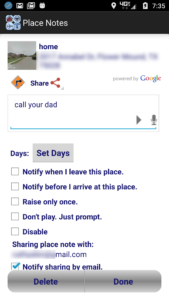 Sharing Reminders (reminding someone else):
Sharing Reminders (reminding someone else):
- Bernie: “Alexa, tell my Avatar to ask Cathy to call her dad when she gets home”
- Alexa: “Cathy will be reminded with note: call your dad, at home.”
iDid is powerful as a family application. You can just as easily share notes with others in your family/friends network by issuing simple commands like the above through Alexa. Note that the note is shared immediately with the friend or family member but is triggered based on the specified condition – “when she gets home”, in this case. The note was created by Bernie and shared with Cathy. Both have the note attached to their home.
The receiver gets a notification on their phone that they have received a note. It is up to the receiver to save it or delete it. All place notes are shared as “notify only” as in they don’t automatically speak out. The receiver can turn them into audio notes.
Reminders based on other events:
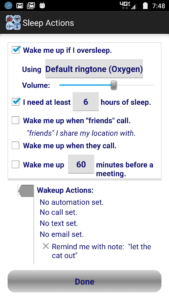
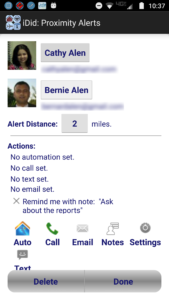 With iDid, you can attach reminders to other events such as when you start driving, stop driving, go to bed or wakeup. You can attach reminders to a friend’s proximity as well. Here are some examples:
With iDid, you can attach reminders to other events such as when you start driving, stop driving, go to bed or wakeup. You can attach reminders to a friend’s proximity as well. Here are some examples:
- Bernie: “Alexa, ask my Avatar to remind me to let the cat out when I wake up”
- Alexa: “Sleep actions set successfully. Please check your i-Did app for details.”
- Bernie: “Alexa, ask my Avatar to remind me to ask Cathy about the reports when we meet”
- Alexa: “A proximity alert has been created between you and Cathy, with action: ask Cathy about the reports.”
- Bernie: “Alexa, ask my Avatar to remind me to take my vitamins before going to bed”
- Alexa: “Sleep actions set successfully. Please check your i-Did app for details.” (iDid learns of your sleeping habits and will remind you 20 minutes before you normally go to bed.)
- Bernie: “Alexa, ask my Avatar to remind me to call Tom as I start driving”
- Alexa: “Drive actions set successfully. Please check your i-Did app for details.”
Using action “text” instead of reminders:
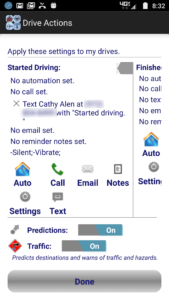
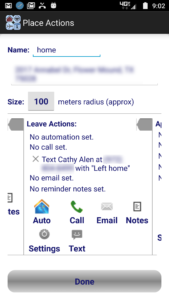 Instead of reminders which are either spoken out or communicated via an app notification, you can set up messaging by text as well. This allows you to reach people who don’t have the iDid app (yet). Texts can be attached to places and events just like reminders. Here is an example:
Instead of reminders which are either spoken out or communicated via an app notification, you can set up messaging by text as well. This allows you to reach people who don’t have the iDid app (yet). Texts can be attached to places and events just like reminders. Here is an example:
- Bernie: “Alexa, ask my Avatar to text Cathy when I start driving”
- Alexa: “Drive actions set successfully. Please check your i-Did app for details.”
Note: You can use first names to reach someone by text if that person is sharing with you or you are sharing with that person. Otherwise, you will have to use their full name and that has to match precisely with a name in your contacts. This is to avoid texting someone inadvertently.
- Bernie: “Alexa, ask my Avatar to text Cathy when I leave work”
- Alexa: “An exit action has been created for place, work, with action: text (555) 123-4567, with Left work.”
Smart Home Commands
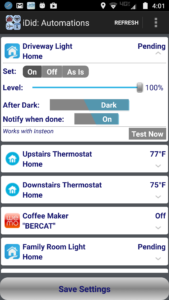 If you have smart home devices that work with Z-wave, Zigbee or Wi-Fi protocols such as Belkin WeMo, Insteon, Kwikset, Lowe’s Iris, Nest, Wink or a host of other suppliers for switches, plugs, doors, locks, etc., you are probably aware that you can issue commands to control these from Alexa. For instance, you can say:
If you have smart home devices that work with Z-wave, Zigbee or Wi-Fi protocols such as Belkin WeMo, Insteon, Kwikset, Lowe’s Iris, Nest, Wink or a host of other suppliers for switches, plugs, doors, locks, etc., you are probably aware that you can issue commands to control these from Alexa. For instance, you can say:
- Bernie: “Alexa, turn the driveway light on”
- Alexa: “Okay.” (after driveway light is turned on by whatever controller you are using).
With iDid, you can teach your smart home system to execute instructions based on several events and conditions. For instance, you can modify the above command and say:
- Bernie: “Alexa, launch my Avatar”
- Alexa: “Hi Bernie. What can I do for you?”
- Bernie: “Turn the driveway light on when I come home”
- Alexa: “An approach action has been created for place, home, with action, automations set: Turn on driveway light.”
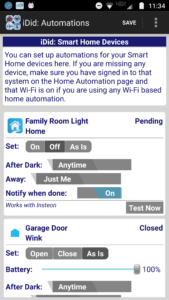 Once set up these commands remain as standing instructions, so the above command will turn the driveway light on every time you come home. You can set the ‘After Dark’ switch to control it further: “Turn the driveway light on when I come home at night” Just as reminders and texts, these automations can be attached to places (arrive, leave and approach), drives (start and stop), sleep and wakeup or to proximity events. For instance,
Once set up these commands remain as standing instructions, so the above command will turn the driveway light on every time you come home. You can set the ‘After Dark’ switch to control it further: “Turn the driveway light on when I come home at night” Just as reminders and texts, these automations can be attached to places (arrive, leave and approach), drives (start and stop), sleep and wakeup or to proximity events. For instance,
- Bernie: “Alexa, launch my Avatar”
- Alexa: “Hi Bernie. What can I do for you?”
- Bernie: “Turn the family room light off when I leave”
- Alexa: “An exit action has been created for place, home, with action, automations set: Turn off family room light.”
Securing Smart Home Automation/Control
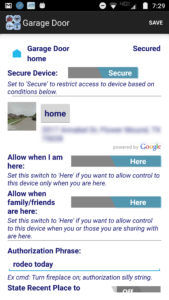 With the iDid application, you can create several rules to secure when and how commands can be issued to your Smart Home devices. These authorization rules are more significant when commands are issued through Alexa.
With the iDid application, you can create several rules to secure when and how commands can be issued to your Smart Home devices. These authorization rules are more significant when commands are issued through Alexa.
From the Home Automations screen, select “Secure Control”. These are the options:
- Mark a device as “Secure” or “Open”. By default all devices except doors and locks are ‘Open’. Doors and locks are ‘Secure’ by default – which means you need to supply some kind of authorization to operate them, as explained below.
- Attach a place to a device: This in general is the place where the device is located, but you can pick any place to enforce this rule. This rule can be applied in two ways:
- Allow commands to this device only when “I am here” – which means you have to be physically at that location for anyone to issue a command either through Alexa or through your phone (“You are where your phone is”).
- Allow commands to this device only when your family is here. In this case, “family” are the ones you are sharing your location with and they are sharing with you as well.
- Specify an “Authorization Phrase” that you will use when issuing the command. For instance, say “turn the fireplace on authorization rodeo today”. Punctuated this sounds like: “Turn the fireplace on; authorization: rodeo today.”
- “State Recent Place”: Instead of an authorization phrase you can state a recent place you visited. You will need to figure out, of your recent places what place names the app accepts as valid for authorization by trial and error. For instance: “Turn the fireplace on; authorization: Great Clips”.
- “Apply to”: For a device, not all functions may have to be secured. For instance, for a lock you may want to secure unlock but allow anyone to be able to lock (perhaps). Select the function you want to secure in the ‘Apply to’ option.
Note that for devices that are marked ‘Secure’, every selected rule must pass. For instance, if you have place based control and an authorization phrase set up, both must pass.
 If a device is “secured”, then authorization rules must pass even while issuing contextual commands (but not during execution). Consider the two command sets:
If a device is “secured”, then authorization rules must pass even while issuing contextual commands (but not during execution). Consider the two command sets:
- Bernie: “Alexa, ask my Avatar to unlock the side door”
- Alexa: “Device is secure. Please provide authorization.”
- Bernie: “Authorization: rodeo today”
- Alexa: “Side door is unlocked.”
- Bernie: “Alexa, open my Avatar”
- Alexa: “Hi Bernie. What can I do for you?”
- Bernie: “Turn the kitchen light on when I come home”
- Alexa: “Device is secure. Please provide authorization.”
- Bernie: “Authorization: purple dinosaur”
- Alexa: “An approach action has been created for place, home, with action, automations set: Turn on kitchen light.”
For the first command, authorization must pass for immediate execution of the command. For the second command authorization must pass for setting up the condition that will trigger the execution (not the execution itself). If authorization was passed and the condition was set up, kitchen light will turn on when you come home – in that example.
Directions
If you are heading out to your next meeting and want to pull directions on your mobile before you start driving, try the commands below. First, on your iDid app, open Automations, Meetings and select the calendars where your meetings are. Set up a few upcoming meetings to test.
- Bernie: “Alexa, ask my Avatar to get directions to my next meeting” (or)
- Bernie: “Alexa, ask my Avatar to get directions to my meeting with Harry”
- Alexa: “12 mins to 3400 FM407, Bartonville, TX 76226 now; normally 10 mins. Before I launch navigation, here’s the overview: Head west on Valley Ridge Blvd toward Frost Ln. Turn right onto Morriss Rd. Turn left onto FM407 W/Justin RdContinue to follow FM407 W. Make a U-turn at Blanco Dr. Opening navigation to: 3400 FM407, Bartonville, TX 76226.”
If you don’t need directions but just want to know where your meeting is:
- Bernie: “Alexa, open my Avatar”
- Alexa: “Hi Bernie. What can I do for you?
- Bernie: “Where am I meeting Harry?”
- Alexa: “12 mins to 3400 FM407, Bartonville, TX 76226 now; normally 10 mins. Do you need directions on your phone?”
- Bernie: “No. Thank you” (You can say, Yes to get directions at this point.)
When these commands are issued, iDid checks to make sure the place is open and gets traffic information.
- Bernie: “Alexa, ask my Avatar to get directions to Costco”
- Alexa: “Costco Wholesale is now closed. Open: Sunday: 10:00 AM to 6:00 PM. 18 mins to Costco Wholesale now; normally 15 mins. Before I launch navigation, here’s the overview: Head east on Valley Ridge Blvd toward Lazy White Daisy Trail. Turn right onto N Stemmons Fwy. Take the ramp on the left onto I-35E S. Take exit 448A toward Grapevine/Mc Kinney/TX-121. Merge onto S Stemmons Fwy. Opening navigation to: Costco Wholesale.”
Expense Reports
If you have turned on expense reports on your iDid app, you can issue commands such as the ones below. Expense reports are currently available only to JP Morgan Chase customers with email alerts set (alerts must be received on the account you use to log in while enabling this feature on the iDid app).
- Bernie: “Alexa, ask my avatar to get my expenses for yesterday”
- Alexa: “Expenses incurred are: $ 45.07 at Tom Thumb. Your expense total for: 2017-02-27, is $ 45.07.”
- Bernie: “Alexa, ask my avatar how much did I spend yesterday”
- Alexa: “Your expense total for: 2017-02-27, is $ 45.07.”
- Bernie: “Alexa, ask my avatar to get expenses for January 1st, 2017”
- Alexa: “Expenses incurred are: $ 42.89 at home. Your expense total for: 2017-01-01, is $ 42.89.”
